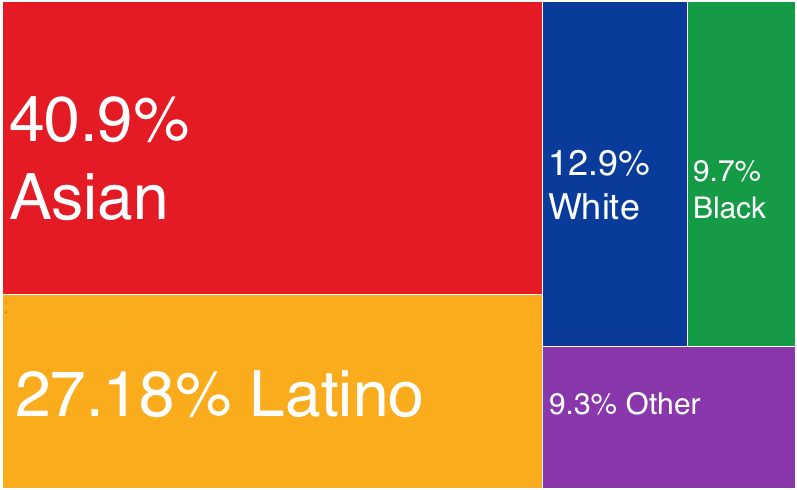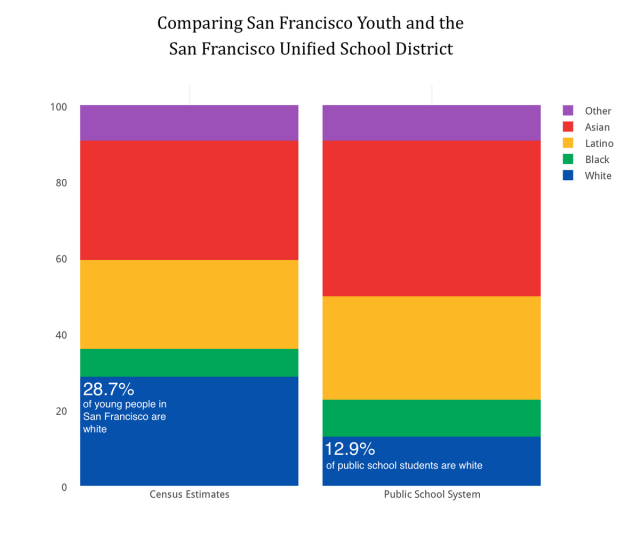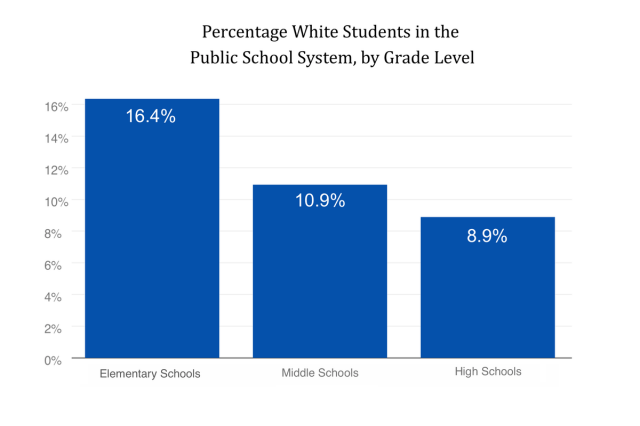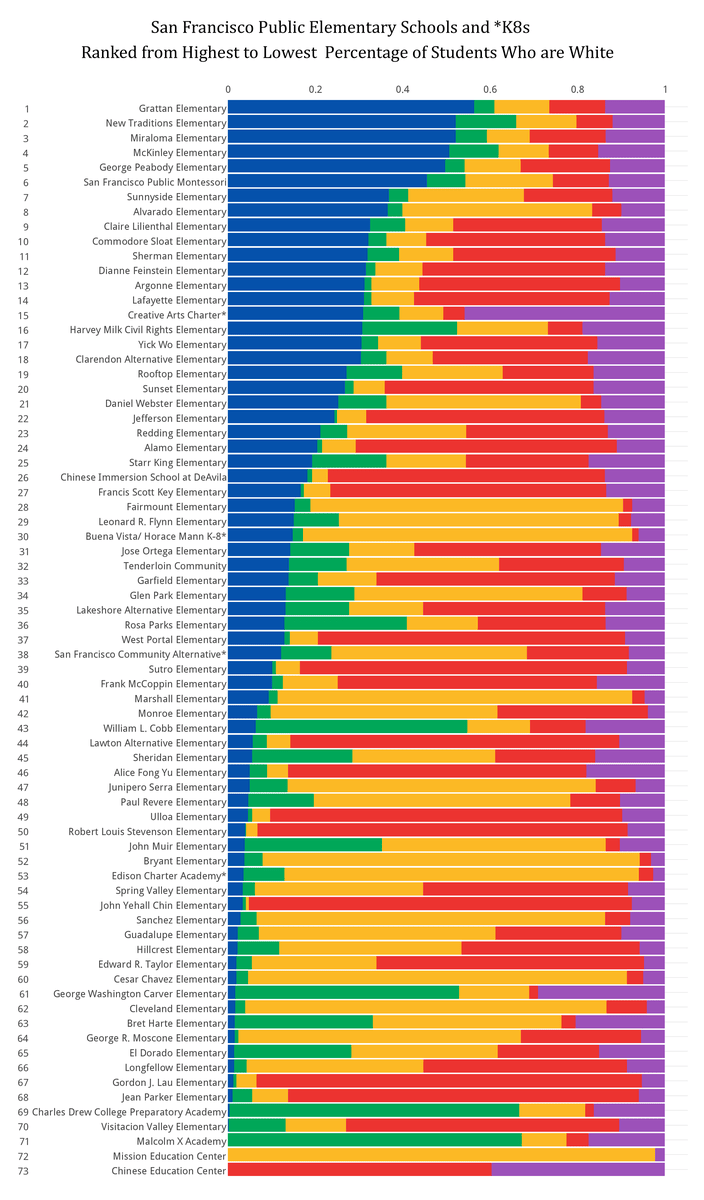
San Francisco Unified School District enrollment by race/ethnicity; Source: CA Department of Education
Recently, our friends at San Francisco Public Press connected us with a really interesting data set: the demographics of San Francisco public schools. There were a lot of eye-opening statistics in the there. For example, in 2014, 58% of the students at public schools qualified for free or reduced-priced lunch based on their families income level — a shockingly high number of a city going through an economic boom.
Another thing stood out to us: There aren’t very many white students in the public school system, even though a lot of white people live in San Francisco. We decided to dig a little bit deeper into the data to figure this out. Where are the white people in San Francisco public schools?
In San Francisco, 41.6% of the overall population is white, according to the Census estimate for 2013. Of the city’s population age 19 and under, 28.7% are white. So you might expect, like we did, that white students would make up about 28-30% of the public school system.
In the 2013-2014 school year, only 12.9% of San Francisco public school students were white.

The bar on the left represents the ethnic breakdown of the population under 20 in San Francisco; the bar on the right represents the public school system; Sources: American Community Survey 2013, California Department of Education
San Francisco public schools are far less white than we expected them to be, whereas all other major racial and ethnic groups are over-represented.
Where are the White People in San Francisco Public Schools?
San Francisco Public Press has a hypothesis about why there are so few white students in the public school system: white San Franciscans are more likely to be able to afford private school:
The average white San Franciscan makes three times more money than the average black resident. Whites on average also make 66 percent more money than Latinos, and 44 percent more than Asians. Possibly as a result of this wealth, white children are much more likely to be enrolled in private schools than other racial groups.
But this isn’t the whole story. It turns out that the white students who are in the public school system tend to be found in very particular places. Mainly, they’re in San Francisco’s elementary schools:

Ratio of white students in San Francisco public schools at different levels of education, 2013-2014. White students make up less of the student body at schools with higher grade levels.
At the elementary level, the overall student body is about 16.4% white, far above the district average. But by middle school that number drops to 10.9%. By high school, only 8.9% of students are white.
White students, it appears, exit the public school system as they get older. Many people who exit the public school system either move to public school districts in the suburbs, or enroll in private schools. San Francisco has the highest rate of private school enrollment in the state, and third highest in the country
Winning “the Lottery”
The admissions process to most public schools in San Francisco involves more randomness than in most school districts. Getting into a mostly-white school in San Francisco isn’t simply a matter of moving into a mostly-white neighborhood. Parents rank their top choices, and are matched with schools based on the schools’ capacity, with a complex system of rules mixed with randomness to settle ties. Many refer to the process as “the lottery.”
However, the white students at each grade level are not at all evenly distributed throughout the city’s schools. The distribution of the percentage of white students skews positive, meaning that there are a few schools with a relatively high percentage of white students, and many more with a low percentage. Half of San Francisco’s high schools have a student population that’s only 5.7% white or less.

The different levels of school also have different distribution tendencies in their rate of white students, 2013-2014. The median percentage in elementary, middle, and high schools is 13%, 9.9%, and 5.7%, respectively. (Compare these to mean percentages, presented in the previous bar chart: 16.4% in elementary schools, 10.9% in middle schools, and 8.9% in high schools.)
Even focusing on the elementary level, the spread of the distribution is astounding. Half of San Francisco’s elementary schools have a student population that is 13% white or less. A few elementary schools are over 50% white, while a quarter of elementary schools are under 3.3%.

San Francisco elementary schools and K8s, ranked from most white to least white, 2013-2014
So while elementary schools may appear to be more diverse than middle and high schools, this is deceptive: The white students in the district are clustered into a handful of elementary schools — such Grattan (which is 56% white), New Traditions (52%), and Miraloma (52%.)
According to Public Press, more affluent families tend to be savvier at the admissions process, and also tend to have the luxury of more flexibility with their preferences. For example, they’re more likely to be willing and able to transport their kids across town every day, if it means attending a particular school. “We have options,” one parent told Public Press, about the kindergarten admissions process. “We can send our kids to private schools. We can travel across town. Not every parent can.”
Those options usually don’t go away as a student ages. If at any point the process doesn’t shake out the way an affluent parent wants, they can just drop out, and shell out for a private education for their child. And, the data suggests, that’s exactly what they do.
***
So we have our answer: white students in San Francisco public schools are mostly in the elementary schools, and only some of them. As these students get older, they tend to exit the city’s public school school system. The result that the school district’s resegregation gets more severe as a student’s level of education gets more advanced.
“If parents have inadvertently helped to resegregate the schools by seeking the best opportunities for their own children,” the Public Press writes, “it may take individual and collective efforts by those same parents to create the diverse public schools many of them say they want.”
This post was written by Rosie Cima; you can follow her on Twitter here. To get occasional notifications when we write blog posts, please sign up for our email list



